#radio frequency antenna
Text

5G 12dBi Magnetic Antenna with RG174 Cable
A 5G 12dBi magnetic antenna is a type of antenna designed to enhance the performance of 5G wireless communication devices, such as routers, hotspots, or modems. Let's break down the key features:
5G: 5G is the fifth generation of wireless technology, which offers faster data speeds, lower latency, and greater capacity compared to previous generations (4G, 3G, etc.). The antenna is specifically designed to work with 5G networks and devices.
12dBi Gain: The "12dBi" figure refers to the antenna's gain, which is a measure of how much the antenna can increase the power of the signal it receives or transmits. A higher gain indicates better signal reception and transmission capabilities. In this case, a 12dBi gain suggests that this antenna can significantly boost the signal strength.
Magnetic Antenna: The term "Magnetic Antenna" indicates that the antenna can be attached to metal surfaces using a magnetic base. This feature provides flexibility in terms of placement and allows for easy positioning on metallic surfaces, like the roof of a car or a metal housing for a 5G device.
Magnetic antennas are often used in mobile applications or in scenarios where temporary or flexible mounting is required. This type of antenna is convenient because it can be easily installed and removed, making it suitable for mobile installations or where drilling holes or more permanent mounting solutions are not practical.
#rf antenna#RF Antennas#RF Antenna at Best Price in India#RF antenna system#radio frequency antenna#Best RF Solution Provider#RF Antenna Suppliers#Manufacturer of RF Antenna#rf antenna manufacturers in india#RF Antenna Manufacturer#RF Antenna Exporters#RF Antenna Latest Price#Wireless HF Antenna#RF Antenna Companies in India#Wholesaler of RF Antenna#RF Antenna Amplifier#RF Antenna Module#2.45 GHz Antenna Module#High Performance RF#Antennas for LoRa and Sigfox#Omni-directional SMD antennas#3.3GHz RF Antennas#RF & Microwave Antenna Manufacturers#Antenna manufacturers in Canada#RF Antenna manufacturers & suppliers - India#RF Antenna made in India#India telecom rf antenna#2.4ghz & 5ghz antenna#multiband antenna#telecom rf antenna products
0 notes
Photo

Novel antenna design with four concentric spirals, each having 2.5 turns. Rf power is connected to the centre and ground is at the outer connectors
Gans, Timo & Crintea, Dragos & O'Connell, Deborah & Czarnetzki, Uwe. (2007). A planar inductively coupled radio-frequency magnetic neutral loop discharge. Journal of Physics D: Applied Physics. 40. 4508. 10.1088/0022-3727/40/15/021.
65 notes
·
View notes
Text
Practical RF Design Manual
[Practical RF Design Manual by Doug DeMaw (Milton F "Doug" DeMaw). 1997. MFJ Publishing. 2nd Edition 1997 : 246 pages. ISBN 1-891237-00-4]
For many years I was an amateur radio - "ham radio" - operator, beginning when I was 13 years old and going up until I was about 40 years old. For those who are interested, my call sign was WA6FEB and I held an Extra Class ham radio license (this is the highest classification). My fascination with radio was fostered by my step-father, the late Sam Martin (WB6WZN, later N7TBV), who had learned his electronics and radio theory while serving in the US Navy.
Sam had many years’ worth of a magazine called QST, which was one of the premier journals available for ham radio enthusiasts. Doug DeMaw, the author of the book under review here, was a prolific contributor to QST and to other ham radio publications. I was (and remain) a huge fan of his writings, especially his transmitter and receiver projects for ham radio folks.
What I did not know then, but have come to learn, is that DeMaw was truly a world-class electrical and electronic engineer. He was known to much of the world as a ham radio person first and foremost, but he was a professional engineer who had an extraordinarily broad grasp of all aspects of radio transmission and reception, covering all power levels from the very tiny (what we in the ham radio community called QRP, or low-power, operation, usually less than 1 watt) to the industrial (the 50,000-watt and 100,000-watt “clear channel” broadcasts from commercial radio stations, for example). DeMaw was well-versed in design considerations spanning operating frequencies from the US AM broadcast band (560 KHz to 1600 KHz) all the way up to the UHF range (where television broadcast channel 14 begins in the US, or around 470 MHz and beyond). His knowledge went beyond component-level design of devices to include the design and tuning of antennas and other auxiliary devices to aid in the radio experience.
All of this knowledge is subsumed under the aegis of RF - radio frequency. RF in modern terms is usually linked to RF ID chips, which are becoming quite common in scenarios that require tracking (such as shipment packages), but this is a very restricted window into the RF world. To really see just how vast an enterprise RF electronics is, one might consult this book.
This volume is truly a gem. I dearly wish I had access to it back in the early 1970s when I was first getting into radio. It would have illuminated a lot of practical design issues for me, especially on the design of receivers. Receivers are generally more complicated and finicky than transmitters – it’s easier to generate radio energy and cast it out into the universe than it is to gather it in and make sense of it. This book leads the reader through 7 broad-based topics and roughly 40 overall subsections within those topics, starting with transmitter and receiver fundamentals and leading the reader through considerations related to power regulation, signal quality, the use of different types of components for different frequencies of operation and different power levels, and so on.
Unlike much of DeMaw’s writing with which I had been previously acquainted, this book is definitely not a book for someone looking to do a home project. There are no comprehensive instructions on assembling or testing transmitters, receivers, or other associated machinery. This book is written for a true engineer who wants to become familiar with many (most) of the gotchas that accompany real in-the-trenches electronic engineering work. And in this vein, this book is as useful to a professional radio engineer (such as someone who is the engineer-in-charge at a radio or television station, for instance) as it is to a radio hobbyist. It is also not the sort of book from which to learn first principles of electronics; for this, there are many more suitable books that introduce electronics at the most elementary level (Ohm’s Law, Kirchhoff’s Law, how vacuum tubes and transistors work, what makes oscillators work, and so on). This book assumes that the reader already has some engineering skin in the game, as the saying goes.
Whom would I recommend this book to? Anyone who wishes to know something about electronics that precedes the modern all-digital era where whole systems are embedded on integrated circuit (IC) chips. While those circuits may make for easier and more controlled design, they take away a lot of the learning, guesswork, and outright fun of figuring these things out for yourself. DeMaw’s work hearkens back to what many of us current and former ham radio people think of as a sort of golden era of communications – a time before cell phones and before email.
A couple of comments about the text itself:
There are some typos both in the text and on the many diagrams. For the most part these are easy to spot if you are already versed in basic electronics, but they would be profoundly confusing to someone who doesn’t know what they’re looking at. Anyone who doesn’t know how to read a basic schematic diagram of a circuit will not find this volume very helpful.
Bearing in mind that some of the material in this book dates to the 1970s and 1980s, it is possible that some of the actual components cited in the text no longer exist or are not easily available. Happily, the author describes them in sufficient detail that a modern engineer or hobbyist can find current components whose characteristics match what DeMaw had at his disposal when the book was written. DeMaw was fairly fastidious about describing the important pieces of each circuit or circuit fragment in the book. One needs but to pay attention to the text to make the connection.
I was delighted to read through this volume. I am not currently an active hobbyist, but as I near retirement age, I am giving a return to ham radio serious thought. With that in mind, this book will be an invaluable title in my collection when I once again wield a soldering iron and set out to make some more home-brew radio equipment as I did so many years ago.


[Photo credits with thanks to : Book Cover of 2nd edition 1 August 1997 © 1997 M F J Enterprises Inc / Portrait © Copyright Holder (apologies not known)]
Kevin Gillette
Words Across Time
10 January 2023
wordsacrosstime
#Kevin Gillette#Words Across Time#wordsacrosstime#Practical RF Design Manual#Doug DeMaw#January 2023#Ham radio#US Navy#QST#Transmitter#QRP#Antenna#Radio Frequency#Power Regulation#Signal Quality#Electronic Engineering#Television Station#Radio Hobbyist#Ohm’s Law#Kirchhoff’s Law#Vacuum Tube#Transistor#Oscillator#Receiver#Sam Martin#Amateur Radio
7 notes
·
View notes
Text
Are EMF’s safe? (come, child, ruin your night)
y’all ready for this?
I’m not anti-5G, btw
turn your wifi off before bed and maybe stop keepin’ ya phone so close all the time
But like... why, though?
I've had my suspicions about cell towers being hazardous to health for a few years now and felt convinced enough to not bother researchin' it for confirmation. Now that I'm blah blah blah, I decided to actually bother. Since it got kinda heavy, I had to ask myself if I should put in hella more effort creatin' a damn research report of sorts for y'all asses present the info for others like it's a damn PSA. And my conscious won. T~T
But like... what, though?
A base station (aka: cell phone tower) is that shit you see everywhere but never notice. It's usually tall af and has panel antennas on it. It's "used for the transmission and reception of the radio signals between the mobile phones and the network." The problem with 'em is the electromagnetic field (EMF) their equipment can give off... for half a mile. 😐
In short, they've been found to cause health problems. Like cancer. 🤷🏿♂️
Fun fact, panel antennas can be installed on the roof/side of buildings that may be directly across the street from someone's workplace... with the antenna at their elevation. 🤷🏿♀️
Real Quick
For those who don’t trust EMF-Portal, it (sometimes) has links to the study/article.
Full-text PDF can be requested directly from the authors on ResearchGate.net’s article for the study.
Full-text PDF can (usually) be found online in English and German with the right search.
5 Studies
V/m = volts per meter
7191 cancer deaths were selected according to the above mentioned criterias out of a total of 22,493 cancer deaths. The most significant causes were lung cancer (19.6 %), stomach cancer (14.1 %), prostate cancer (12.6 %), and breast cancer (11.5 %). The mean electric field intensity of the measurements in 2008 was 7.32 V/m, varying from 0.4 to 12.4 V/m.
At a distance of up to 100 m [328.08 ft], the absolute number of deaths was 3569, (49.6 % of all deaths), the mortality rate was 43.4 persons per 10,000 [0.43%] and the relative risk was 1.35 in relation to the mortality rate of 32.1 per 10,000 [0.32%] inhabitants of the entire Belo Horizonte municipality [in Minas Gerais, Brazil]. A mortality rate of 34.8 per 10,000 [0.35%] inhabitants was observed for the residents living within 500 m [1,640.42 ft] of the base stations; this rate decreased for residents living farther from the base stations.
—Mortality by neoplasia and cellular telephone base stations in the Belo Horizonte municipality, Minas Gerais state, Brazil; Science of The Total Environment (2011); EMF-Portal
ResearchGate.net’s article


The result of the study [of 967 permanent residents] shows that the proportion of newly developing cancer cases was significantly higher among those [320] patients who had lived during the past ten years at a distance of up to 400 metres [1,312.34 ft] from the cellular transmitter site, which has been in operation since 1993, compared to those patients living further away, and that the patients fell ill on average 8 years earlier. In the years 1999-2004, ie after five years' operation of the transmitting installation, the relative risk of getting cancer had trebled for the residents of the area in the proximity of the installation compared to the inhabitants of Naila[,Germany,] outside the area.
—The Influence of Being Physically Near to a Cell Phone Transmission Mast on the Incidence of Cancer (original title: ‘Einfluss der räumlichen Nähe von Mobilfunksendeanlagen auf die Krebsinzidenz’); Umwelt · Medizin · Gesellschaft (2004); ResearchGate.net
EMF-Portal

9 cancer cases were observed in the first period 2000 - 2004 and 14 cases in the period 2005 - June 2007 among [1,283] residents living within a radius of 400 m [1,312.34 ft] to a mobile phone base station [in Germany (Hennen, suburb of Iserlohn, Westfalia)]. The mean age of disease onset was 59.2 years in the first period and 59.3 years in the second period in comparison to the expected value of 66.4 years evaluated from the Saarland Cancer Registry. The authors concluded, that a statistically significant increase of cancer incidence was observed 5 years after the base station has been started operating.
—[Incidence of cancer adjacent to a mobile telephone basis station in Westfalia] (original title: Krebsinzidenz von Anwohnern im Umkreis einer Mobilfunksendeanlage in Westfalen - Interview-basierte Piloterhebung und Risikoschätzung); Umwelt · Medizin · Gesellschaft (2009); EMF-Portal
Area A: ≤ 350 m / 1148.3 ft from base station
Area B: > 350 m / 1148.3 ft from base station
Of the 622 people of area A, 8 cases of different kinds of cancer were diagnosed in a period of one year (from July 1997 - June 1998). The cancer incidence rate was 129 cases per 10,000 [1.29%] persons per year in area A compared to 16/10,000 [0.16%] in area B and 31/10,000 [0.31%] in the town of Netanya [in Israel]. Relative cancer rates for females were 10.5 for area A, 0.6 for area B and 1 for Netanya.
The authors conclude that the study indicates an association between increased incidence of cancer and living in proximity to a mobile phone base station.
—Increased incidence of cancer near a cell-phone transmitter station; International Journal of Cancer Prevention (2004); EMF-Portal
ResearchGate.net

Took forever to get this damn infographic just right. >.>
A long-term study was conducted in Germany to investigate the influence of a mobile phone base station on neurotransmitters under true-to-life conditions.
µW/m² = microWatts per square meter
24 out of 60 participants were exposed to a power density of < 60 µW/m², 20 participants to 60 - 100 µW/m², and 16 participants to more than 100 µW/m² .
The values of the stress hormones adrenaline and noradrenaline grew significantly during the first 6 months after starting the GSM base station; the values of the precursor substance dopamine substantially decreased in this time period. The initial condition was not restored even after 1.5 years. Due to the not regulable chronic difficulties of the stress balance, the phenylethylamine levels dropped until the end of the investigation period. The effects show a dose-effect relationship and are situated far under the valid limit values.
—[Modification of clinically important neurotransmitters under the influence of modulated high-frequency fields - A long-term study under true-to-life conditions] (original title: Veränderung klinisch bedeutsamer Neurotransmitter unter dem Einfluss modulierter hochfrequenter Felder - Eine Langzeiterhebung unter lebensnahen Bedingungen); Umwelt · Medizin · Gesellschaft (2011); EMF-Portal
ResearchGate.net’s German article
EMF:data page (German)
While I did find 17 different figures for it, I’mma save myself the bother of describin’ dat noise and not include ‘em thanks~.
But what does the FCC say?
FCC.gov’s conclusion seems to be that they’re generally safe for civilian life as long as you don’t get close and aren’t directly in front of the antenna’s trajectory (don’t climb a fuckin’ tower or enter those rooms/buildings). A very “it’s fine” set of conclusions tbh. Hella contrasted by other sources.
Nonetheless… below is the index...
FCC’s RF Safety FAQ Index:
What is "radiofrequency" and microwave radiation?
What is non-ionizing radiation?
How is radiofrequency energy used?
How is radiofrequency radiation measured?
What biological effects can be caused by RF energy?
Can people be exposed to levels of radiofrequency radiation and microwaves that could be harmful?
Can radiofrequency radiation cause cancer?
What research is being done on RF biological effects?
What levels are safe for exposure to RF energy?
Why has the FCC adopted guidelines for RF exposure?
How safe are mobile phones? Can they cause cancer?
How can I obtain the specific absorption rate (SAR) value for my mobile phone?
Do "hands-free" ear pieces for mobile phones reduce exposure to RF emissions? What about mobile phone accessories that claim to shield the head from RF radiation?
Can mobile phones be used safely in hospitals and near medical telemetry equipment?
Are wireless and PCS towers and antennas safe?
Are cellular and other radio towers located near homes or schools safe for residents and students?
Are emissions from radio and television antennas safe?
How safe are radio antennas used for paging and "two-way" communications? What about "push-to-talk" radios such as "walkie-talkies?"
How safe are microwave and satellite antennas?
Are RF emissions from amateur radio stations harmful?
What is the FCC's policy on radiofrequency warning signs? For example, when should signs be posted, where should they be located and what should they say?
Can implanted electronic cardiac pacemakers be affected by nearby RF devices such as microwave ovens or cellular telephones?
Does the FCC regulate exposure to radiation from microwave ovens, television sets and computer monitors?
Does the FCC routinely monitor radiofrequency radiation from antennas?
Does the FCC maintain a database that includes information on the location and technical parameters of all the towers and antennas it regulates?
Which other federal agencies have responsibilities related to potential RF health effects?
Can local and state governmental bodies establish limits for RF exposure?
Where can I obtain more information on potential health effects of radiofrequency energy?
The Government Accountability Office (GAO) prepared a [2012] report of its investigation into safety concerns related to mobile phones. The report concluded that further research is needed to confirm whether mobile phones are completely safe for the user, and the report recommended that the FDA take the lead in monitoring the latest research results.
Professional Opinion...
Safe Distance from Cell Towers…
It is also difficult to predict a safe distance from cell towers. For example, cell towers are designed to transmit most of their radio frequency (RF) energy horizontally. Some areas below the tower may have lower levels than locations farther away that are more in line with the vertical height of the antennas.
The exposure from a cell tower will depend on the type of antennas, the number of antennas, how much the antennas are actually being used, the time of day, etc. The distance needed to reduce exposures down to the General Public Precautionary Level of 100 microwatts per meter squared (μW/m²) is often around a quarter of a mile (1320 feet) or more. Due to the uncertainty, on-site testing with a broadband RF test meter is strongly recommended.
A German study reported that people living within 400 meters (1312 feet) of cell towers had over 3 times the normal rate for new cancers (City of Naila 2004). In an Israeli study, the relative risk for cancer was about 4 times greater within 350 meters (1148 feet) of the cell tower (Wolf et al. 1997). Based on findings like these, a minimum safety distance of 1/4 mile (1320 feet) might be considered prudent.
(...)
The suggestions for safety distances in this chart are generally based on Michael Neuert’s [engineer, licensed electrician, and health educator] professional on-site testing of the various EMF sources in the San Francisco Bay Area since 1992.
—What Distance is Safe? By Michael R Neuert, MA, BSME, ©2023
helpful table if you want all that info: What EMF Level is Safe? By Michael R Neuert, MA, BSME, ©2023
i know what i said
Based on the accumulated evidence, we recommend that IARC [the International Agency for Research on Cancer] re-evaluate its 2011 classification of the human carcinogenicity of RFR [radio-frequency radiation], and that WHO [the World Health Organization] complete a systematic review of multiple other health effects such as sperm damage. In the interim, current knowledge provides justification for governments, public health authorities, and physicians/allied health professionals to warn the population that having a cell phone next to the body is harmful, and to support measures to reduce all exposures to RFR.
—Risks to Health and Well-Being From Radio-Frequency Radiation Emitted by Cell Phones and Other Wireless Devices; Front Public Health (2019 Aug 13); NCBI
Lookup (or pull out) your cellphone’s manual and search for the sections on “radio frequency exposure” and “Specific Absorption Rate (SAR) information” to see how close the phone can safely be kept near your body… and that it should be kept away from “the bellies of pregnant women and for teenagers, away from the lower abdomen.” 😐
For an informative giggle, here’s the “Harmful Cell Phones” segment from season 7 of The Colbert Report.
#research#long post#scientific study#telecommunications#telephone base stations#mobile phone base stations#cell towers#cell sites#transmission masts#basis stations#panel antennas#EMF#wifi#cell phones#radiation#cancer#ResearchGate#FCC#RF Safety#radio-frequency radiation#IARC#World Health Organization#physical health#mental health#EMF-Portal#nothin' to see here people#just another day(s) of my life wasted#move along#pretty sure i saw a lone panel antenna relatively low af on a street light pole once
1 note
·
View note
Text

The E-passport Market size was valued at USD 22.50 billion in 2021 and is predicted to reach USD 88.90 billion by 2030 with a CAGR of 21.7% from 2022-2030.
#E-Passport Market#Radio Frequency Identification#Biometrics#Facial Recognition#Fingerprint Recognition#Iris Recognition#Hardware#Antenna#Processor/Chip#Software#Services#Leisure Travel#Business Travel#Basic Access Control (BAC)#Password Authenticated Connection Establishment (PACE)#Supplemental Access Control (SAC)#Extended Access Control (EAC)#Ordinary E-passport#Service#Diplomatic E-Passport
0 notes
Note
IM OBSESSED WITH ALASTOR X VOX!SISTER READER! (also hi its pixie again lmao)
ok so i was thinking that since vox!sister reader is a “pampered princess” because vox has the power and money to give her anything, alastor does the same! so after a day of hanging out with alastor and shopping and stuff, vox!sister reader goes back to the vees tower wearing red (alastors color, while her clothes r mostly blue to match with vox) vox immediately gets reminded of alastor seeing her clothes and he gets rlly angry and jealous and stuff, and ofc since alastor is a cocky little shit, he makes a broadcast for vox to hear to tell him how much of a good time he and his sister had to piss him off even more! :3
I enjoy writing Vox!sister with Alastor. It brings me joy knowing Vox is just gnawing at his wires knowing Alastor and his baby sister are a couple in very sense of the word hehehe~
————————————————————————————————-
You loved when Alastor took you shopping. Through you could and did have anything you wanted thanks to your brother, it was nice that your lover still chose to spoil you just as much. Today you were out buying a whole new wardrobe and decided that you were in need of a new color scheme. You always wore blue. It was your signature as Vox’s sister and a color you declared only you could wear. But as of late, you strayed from the comforting color to a more fiery palette.
“I’m home!” You shouted even though you knew your brother already knew you were home. You had your assistant bring all your bags in and you heard the familiar zap of Vox entering the common area. “Finally! I thought I was gonna have to-what the fuck are you wearing?” Vox growled. You smiled and spun around “isn’t it the cutest!? Never thought of myself as a red girl but this color is gorgeous!”
Vox screen glitched. You were wearing red and black. Your usual blue completely gone and replaced by the radio demon’s colors.
”You spent money to look like that fossil? Sis we just finished your closet like last week”
You pouted and shrugged “A few different pieces dont hurt, besides I think its cute to match with my boyfriend”
That’s right how could he forget that Alastor was dating his baby sister.
You skipped to your room with your bags and began to reorganize your closet. Again.
Vox growled as he rubbed his screen.
His antennas buzzed at the change of frequency and his mood became even more sour as Alastor voice filtered through.
”Salutations wayward sinners! I just had a wonderful time with my girlfriend. You lot might know her as the Voxtech pampered princess. Yes yes i know what you’re all thinking…”
Vox eye twitched.
”me and the little lady had quite a time shopping today. That darling is a looker I tell you, she can make anything look good. My those hips and legs really know how to make a man sweat” Alastor laughed.
”Anyway you might notice the Vees tower slowly changing. I think red is a lovely color and so do my darling.Maybe be on the lookout for a new design change folks. After all blue is such a dull color hehehe”
Vox was fuming.
”I am so going to kill him”
#hazbin hotel#hazbin alastor#alastor#hazbin hotel fanfiction#jyoongim#alastor x reader#alastor x y/n#alastor the radio demon#alastor hazbin hotel#vox x reader#vox hazbin hotel#vox the tv demon#hazbin hotel vox#the vees#hazbin vox
433 notes
·
View notes
Text
Sooo about Vox and Alastor...
The Radio Demon controls radio waves. Guess what?
Over-the-air television: Television broadcasting through radio waves, from a transmitter (TV station) to a receiver (TV antennae)
Satellite television: A TV signal transmitted by radio waves from a satellite.
Cable television: Radio frequency signals transmitted via cables
Until the early 2000s, TV signals were entirely transmitted through analogue signals: for decades, the original television technology only worked thanks to RADIO technology.

Those antennae on Vox's head? They're 'rabbit ears'!! Dipole receivers, meant to intercept radio waves broadcasted by TV stations, convert them to radio frequency electric currents, and send those to the TV via a radio currents transmission line, to be converted and processed to produce pictures and sounds.

It makes perfect sense for Vox and Alastor to have been "pals". Alastor calls him an " old pal" mockingly, but there's no way Vox would have been able to implement any kind of TV technology in Hell without the help of radio technology - technology that Alastor had control over. For decades, TV was literally radio with pictures. Alastor used to tolerate him (despite Vox encroaching on his territory) at worst, but might have supported him at best!
In my opinion, the beef between them comes from Vox's transition from Analogue to Digital, aka the digital switchover.
When Vox asked Alastor to join his team, it's possible he suggested Alastor switches to digital radio broadcasting (better sound quality, less transmission power required, a compressed digitized signal that allows for more radio programs in the same radio spectrum...). Of course, Alastor didn't care for that.
Was Vox's transition (partly) motivated by a desire to be more independent from Alastor? In any case, he's certainly not that much more independent now: streaming television and the streaming platforms & other services available on digital TVs depend on internet connectivity. And Wi-Fi uses radio waves.
In other words: Alastor's radio waves still live in Vox's TV head rent free, in the most literal way possible :3
#hazbin hotel vox#hazbin hotel alastor#radiostatic#staticradio#one sided radiostatic#even more so if those antennae still work...#that means alastor has a direct access to vox's head (could he hypnotize him??)#hazbin hotel thoughts
546 notes
·
View notes
Text
"Clothing tags, travel cards, hotel room key cards, parcel labels … a whole host of components in supply chains of everything from cars to clothes. What do they have in common? RFID tags.
Every RFID (Radio Frequency Identification) tag contains a microchip and a tiny metal strip of an antenna. A cool 18bn of these are made – and disposed of – each year. And with demands for product traceability increasing, ironically in part because of concerns for the social and environmental health of the supply chain, that’s set to soar.
And guess where most of these tags end up? Yup, landfill – adding to the burgeoning volumes of e-waste polluting our soils, rivers and skies. It’s a sorry tale, but it’s one in which two young graduates of Imperial College London and Royal College of Art are putting a great big green twist. Under the name of PulpaTronics, Chloe So and Barna Soma Biro reckon they’ve hit on a beguilingly simple sounding solution: make the tags out of paper. No plastic, no chips, no metal strips. Just paper, pure and … simple … ? Well, not quite, as we shall see.
The apparent simplicity is achieved by some pretty cutting-edge technical innovation, aimed at stripping away both the metal antennae and the chips. If you can get rid of those, as Biro explains, you solve the e-waste problem at a stroke. But getting rid of things isn’t the typical approach to technical solutions, he adds. “I read a paper in Nature that set out how humans have a bias for solving problems through addition – by adding something new, rather than removing complexity, even if that’s the best approach.”
And adding stuff to a world already stuffed, as it were, can create more problems than it solves. “So that became one of the guiding principles of PulpaTronics”, he says: stripping things down “to the bare minimum, where they are still functional, but have as low an environmental impact as possible”.
...how did they achieve this magical simplification? The answer lies in lasers: these turn the paper into a conductive material, Biro explains, printing a pattern on the surface that can be ‘read’ by a scanner, rather like a QR code. It sounds like frontier technology, but it works, and PulpaTronics have patents pending to protect it.
The resulting tag comes in two forms: in one, there is still a microchip, so that it can be read by existing scanners of the sort common within retailers, for example. The more advanced version does away with the chip altogether. This will need a different kind of scanner, currently in development, which PulpaTronics envisages issuing licences for others to manufacture.
Crucially, the cost of both versions is significantly cheaper than existing RFID kit – making this a highly viable proposition. Then there are the carbon savings: up to 70% for the chipless version – so a no-brainer from a sustainability viewpoint too. All the same, industry interest was slow to start with but when PulpaTronics won a coveted Dezeen magazine award in late 2023, it snowballed, says So. Big brands such as UPS, DHL, Marks & Spencer and Decathlon came calling. “We were just bombarded.” Brands were fascinated by the innovation, she says, but even more by the price point, “because, like any business, they knew that green products can’t come with a premium”."
-via Positive.News, April 29, 2024
--
Note: I know it's still in the very early stages, but this is such a relief to see in the context of the environmental and human rights catastrophes associated with lithium mining and mining for rare earth metals, and the way that EVs and other green infrastructure are massively increasing the demand for those materials.
I'll take a future with paper-based, more humane alternatives for sure! Fingers crossed this keeps developing and develops well (and quickly).
#I do really wish it could be read by regular scanners already though#that's what I thought at first#and that would've been fucking amazing#but this is still pretty cool#electronics#science and technology#green technology#ewaste#landfill#lithium#lithium mining#human rights#environment#climate action#climate hope#rfid#rfid technology#rfid tags#good news#hope
394 notes
·
View notes
Text
Here, Kitty Kitty

Summary: Miguel O'Hara is your world's Black Cat.
A/N: me when there's no fanfic of miguel as black cat: fine, ill do it myself
Art: Marbipa on twt
Miguel x Reader, No warnings, a little suggestive but that's it, Word Count: 2,535

Swinging on your webs, you hopped from building to building and made sure to to keep an eye out for any more crime during your patrol. You hoped that tonight would be a breeze but unfortunately, the life of a superhero will never rest.
You landed by one of the police antennas and heard a call coming through their radios. Tilting your head, you focused on the frequencies to get a better signal.
"All units be advised. We've got a call for a robbery in Lower Manhattan. Heading there now, requesting backup."
You glanced up at the sky seeing the moon illuminate brightly. "I guess I could help the boys in blue." You shrug and thwip your web shooters, the silk spinning and sticking to another building before jumping off to gain momentum. You hauled yourself up after swinging, diving down between apartments and just barely slipping through a couple fire exits.
You thought about who it might be this time. Maybe it was the Shocker again. Oh, he was always so easy to make fun of. No, that wasn't possible: you put him in prison. You just hoped it wasn't another one of Tombstone's men--they were always a little too cocky. Maybe just a couple of randoms trying to make extra cash the wrong way–a boring way to end the night but at least it'd be easy.
You swung faster after hearing the sirens of police cars echoing throughout the night of New York. You saw a few police cars behind you and you giggled to yourself, playing a one sided game of who would get there faster.
Always the competitive one you were, you stuck your webs onto two poles and pulled back so hard that they bent slightly. Your forearms burned until you let go, slingshotting yourself in the sky and allowing yourself to glide above the city. You wished to take off your mask and feel the breeze properly but you settled for the ripples flapping on your suit.
"Robbery, robbery, robbery..." You murmured, swiveling your head around to see where the robbery could've been. You blinked as you spotted the familiar colors of blue and red flashing in the distance. "Robbery!" You grinned.
Zipping through the wind, you landed above what you now see is a jewelry store. You crawl into the shadows, making sure none of the policemen could see you. "Hm. I guess they win this time." You mutter to yourself about your little game. Perching on the ledge, you listened in on their conversation.
"Any security footage?" One policewoman asks.
"We're checking them now but so far after entering the perimeter, all cameras have been damaged."
"Did you see what was stolen?"
"A few rings and bracelets. But the owner is more concerned with a diamond necklace. Says it was going to be auctioned off later this weekend."
You tilt your head in thought. And they got away? Definitely not some regular citizens. You began to feel a headache creep on you. You couldn't handle another big bad to fight this weekend.
You stepped down from the ledge carefully and walked around the top of the building to find a vent. Once you did, you ripped it open and crawled inside, your body sticking to the ceiling. You looked around and saw various cases filled with glittering jewels, ranging in size and colors. You crawled through another room and hopped off the ceiling with a small thud. Looking behind you, you made sure no one had seen you and you began rummaging through the room to find any evidence lying around to catch the perpetrator.
You found yourself in front of the glowing case in the middle. You circled around it, the eyes of your mask squinting at the empty sloth that would've fit a giant diamond necklace inside. The glass was perfectly intact instead of ruthlessly shattered. This was no common thief. No fingerprints, everything was spotless and clean. You took a closer look.
"Looking for this, arañita?" You hear a smooth voice behind you. You spin around, shooting your webs to trap the wrist of the stranger behind you to the wall.
The familiar tall man you've had a complicated relationship with, Miguel O'Hara a.k.a. Black Cat. His skin tight black suit hugged his built body, white fur fluffed at his forearms and around his shoulders. His suit was opened at his chest, a long slit that gave everyone a nice view of his tanned skin littered with little black and graying hairs. His dark brown eyes were decorated with a thin diamond shaped mask that did little to hide his ‘secret identity’. His dark brown hair was in its usual slick back, gray strands curling in his locks and a pretty black collar around his neck.
He tilted his head at you and lifted his other hand to cut your webs off him with an extracted claw. “Eso es como se trata un amigo? I thought your whole thing was being friendly, arañita.” Miguel says light-heartedly, unphased at the way your mask narrowed at him. You noticed that the hand you had webbed up was holding onto a pouch.
Miguel slips open the pouch by its strings, lifting out the diamond necklace. He clips it around his neck and it shines in the moonlight that seeps through the ceiling window. He admires his reflection in the cases, his gloved hand caresses the jewels, his nail being gentle with grazing over it. “Isn’t she just a beauty? She’s not my style, personally, but I can appreciate her.” His eyes meet yours and he grins. “I think you would make it look even more beautiful.”
You ignore his blatant flirting, your hands itching at your sides, wanting to snatch the pouch from him and return it to the police so the owner could have a good night’s rest–so you could have a good night’s rest. Now knowing the one behind this was Black Cat, your headache had gotten worse and you knew it’d be a long night. Miguel stalks up to you after taking the necklace off and placing it back in his pouch.
“What’s wrong, arañita? Cat got your tongue?” He smirked, his claw grazing under your chin and making you look up at him. You bit down on your tongue. This cat always had a way of pissing you off.
“I thought we agreed you’d put this behind you. You’re rich. What more could you possibly want?” You grab his wrist and take his hand off from your chin.
“Would you believe me if I said I just wanted your attention?” His lips curl up, showing off his fangs.
“No.”
“Ouch. I’m hurt. I thought we had something.” His smile doesn't falter.
“Give back the jewels, Miguel.”
‘Hmm. No. These could go for a lot of money. Way more than whatever that auction it is they’re doing.”
“Miguel, you promised me you would be good.”
His eyes soften for a split second. The memory of your last encounter months ago where you two had spent the night together in the city up on the Empire State building. Your relationship was a confusing one. There had been nights where you were on opposite sides and other nights where he answered your call for help.
Miguel began to trust you. Despite his tendencies to slip between your fingers, you always spoke to him kindly when he wasn’t pushing your buttons–even then he knew you never harbored any actual hatred for him. So after a long night, he confided in you that this was his new life and it wouldn’t change–he’d always come back to a life of crime, it’s who he was. You believed he was better than that.
That night before he disappeared for months, he pulled up your mask just enough to see your lips and he kissed you, leaving with a promise to do better. But cats were known to do whatever they wanted.
“You know I’m not good like you, arañita.” His smile turns melancholy.
“But you could be.” You insisted. “Give me the pouch.”
“I can’t do that, amor.”
You huffed through your nose, jaw clenching, and you tried to snatch the bag from his hand as quickly as you could. Miguel was faster, his clawed hand grabbing you and forcing you to bend over the glass display of jewelry with your arm behind your back.
You grunted when your cheek met the hard glass and attempted to worm your way out of his hold. You feel Miguel lean over your body, his warm breath whispering next to your ear.
“I've thought about you like this. Maybe with a little less clothing.” He teases and chuckles when you stiffen.
“Miguel.” You warn lowly.
“It's been nice seeing you again, arañita, but I've got to run.” You hear a dull clanking sound along with a small whizz.
You felt rope like strings wrap around your body and arms and suction themselves to the glass he slammed you on, trapping you.
Shit.
You crane your head as much as you could to see Miguel take a step back away from you. Just for shits and giggles, he plucks a pair of earrings from a stand and places it inside his bag before raising his hand up at the ceiling window.
Miguel gives you a wink and a charming smile and his grappling hook zips out from his wrist, denting itself in the wall. It pulls him up and he pops the window open, successfully escaping without leaving a trace.
You groan and knock your forehead on the cold glass. With your strength, you pop the rope off you, stretching your arm and wrist out.
Police began to enter inside the building, their commotion and their comms going off and getting closer to you.
Collecting the ropes, you webbed yourself out through the same window Miguel used and closed it behind you. You tossed the ropes away and began swinging around, trying to sense any trace of Miguel.
“Dammit, kitty.” You mutter under your breath. You ignored the way your heart pounded as you scanned every nearby corner. The sight of him after so long sent flutters in your stomach. You ignored the lingering hot touch of his fingers around you, the weight of his body towering over yours. His hips that gently bucked up against–
You tumbled on the roof of a brick building. This was not how you wanted your night to go. You let out deep breaths, your arms and legs spread out as you lay on your back.
After a couple of minutes, you sat up. You ripped your mask off and rubbed the sleep out of your eyes. You felt a turmoil of emotions.
When Miguel had kissed you that night, it broke your heart. He felt so sure of himself to give you affection but at the cost of his disappearance right after. It hurt but you thought if he could turn his life around for the better, it'd be worth all the heartbreak and what ifs.
You stood up and placed your mask back on your head, your arm raising up to shoot a web when your spider senses alerted you of someone.
You turn around to see Miguel, half of his body in the shadows.
“I don't have the pouch so don't shoot.” He raises his hands in a mock surrender.
“Didn't you say you needed to run?” Your voice spits and Miguel nods.
“I also said it was nice to see you again.” He walks up to you, his hands gently placing themselves on your hips. You stand tall, not wanting him to know his effect on you. “So forgive me, I'm a little selfish. I wanted to see you one more time.”
“Why are you back?” You mumble. Why are you back in New York?
“I'm sorry, corazón. You know me. It's what I do.”
“So you lied to me.”
Miguel winces. “No. No, I didn't. I tried, believe me.” His hands squeeze your hips. “I tried for you but…it's not for me. This,” He gestures to himself, clad in black spandex and white fur. “This is who I am now. It's how I have to live.”
He cups your cheek, his thumb caressing your mask-covered face. He wonders what you looked like underneath. Were you as beautiful as your body? Your heart? He dreamed so. He knew so.
“I still don't believe that.” You whisper, leaning into his touch, hands slowly going around the back of his neck and he takes it as an invite to bring you closer.
“You're still so naive.” He murmurs.
“You said you liked that about me.” You quipped. Miguel chuckles.
“I did say that.”
You feel a smile creep up on your face, your heart feeling lighter at the sound of his laugh.
“Hopefully we'll cross paths more often now that I'm back in New York.” Miguel grins. “Te extrañe.”
“I missed you too.” You whisper. With your chest pressed up against his, you could faintly feel the rumble of him purring. Miguel's claws run under your throat, flicking up the fabric of your mask to expose just a bit of your neck as if wanting to lift it off. “But you know I have to turn you in for robbing.” You add.
“Hm. A shame.” He mumbles dismissively. He continues to ride up your mask and you let him. He stops at your nose and leaves it there, eyes focused on the way your lips parted.
“Kiss for good luck?” He asks. His eyes glint when you licks your lips subconsciously.
“You’re pushing it, kitty.” You mumble back but your arms tighten around him. Miguel purrs at the pet name.
“Just one kiss.” He insists, leaning down to brush his lips against your mask where your forehead was.
You tilt his head further down with your hand at the back of his head and he follows. With your guidance, his lips find yours and your heart skips a beat. Miguel tugs you closer by the waist, pressing your chest and hips together. His hands crawl up your spine while he tilts his head to deepen the kiss. You match his pace with your eyes closed while you feel his soft lump lips caressing yours.
You didn’t know how long the kiss lasted–not when his hands roamed your body, squeezing you and devouring as much of your tiny moans as he could. Your hands curled up at the base of his neck while he swiped his tongue across your bottom lip. Gasping, you allowed him access but he pulled away.
“I’ll see you next time, arañita.” Miguel whispers against your lips,the fangs of his teeth gently nibble on your top lip before he pulls away. He squeezes your waist, his touch lingering and aching to keep you near but he lets go. He takes a step back from you and jumps back into the night, the sound of his grappling hook zipping through the air faintly.
You sigh, trying to slow down your heartbeat with a hand over your chest when suddenly you pause.
“Dammit…” You huff and kick a pebble away from you.

a/n: black cat miguel o'hara if you can hear me, please save me, save me black cat miguel o'hara
#miguel o'hara x reader#miguel o'hara x y/n#miguel x reader#miguel o'hara x you#atsv miguel#miguel o'hara#miguel spiderman#miguel spiderverse#miguel ohara#spiderman 2099#miguel x you#spiderman 2099 x reader#miguel o'hara imagine
831 notes
·
View notes
Text
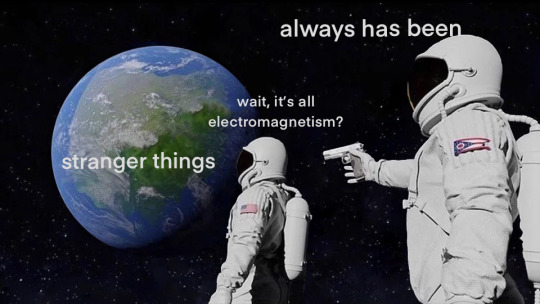
TL;DR: HNL was studying how to give human subjects electromagnetic, most specifically visible light based, powers in order to bend space-time for their needs.
I’m going to try and condense this as much as I can because considering electromagnetism as a major force in ST (pun intended) opens up so many potential areas of analysis that can only be a brief cover of without turning into multiple essays.
Let’s go over the electromagnetic spectrum:
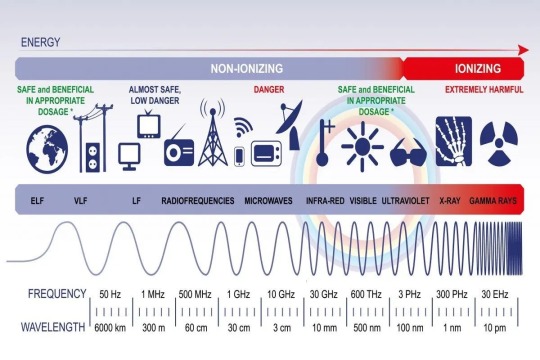
I hope you might already be recognizing some symbols we see often in Stranger Things, especially if you’ve been following the BTS and some location and set leaks from Season 5.
The electromagnetic spectrum encompasses the different frequencies of electromagnetic radiation - waves of energy that travel at the speed of light (and produce visible light to us at certain frequencies). You’ve probably heard of most of these, including cancer-causing gamma rays and x-rays, the visible light spectrum (the rainbow), microwaves, and radio waves.


In S5, we have the radio station as a main location for the characters. They’re also driving around in the radio station’s van, which has an image of a hawk emitting a rainbow (visible light radiation). Steve’s car also has a massive antenna on top of it. My first thoughts were that the team was trying to keep in contact with Max in hopes of her being able to hear them in her coma, considering she has a radio near her bedside. While that still may be a reason, I think the characters may have come to realize how important electromagnetic fields could be in their fight against Vecna (this where leader of the AV Club also focused on electromagnetic objects Scott Clarke may make his triumphant return).
Now to pivot onto why electromagnetism is so important to the lore of ST:
What the scientists in Hawkins Lab are likely studying is a way for human brains to produce or manipulate certain types of electromagnetic waves through telepathy. Most obviously this is seen by them having the kids try to manipulate and turn on a circle of light bulbs. Our brains actually already produce electromagnetic waves, but at a very slow frequency. The scientists are constantly measuring brain waves while conducting these experiments. We even get full shots of El’s brain waves during NINA, for example. We also see similar shots in S2 while Will is in the HNL.


You can also observe that the Hawkins National Laboratory has absolutely massive satellite dishes on it’s rooftop; ones that do not exist on the real life building but are added in post because they pose some sort of significance. Nudge, it’s because they are transmitting and receiving massive amounts of electromagnetic waves.

Why are they studying electromagnetic waves then?
They are studying electromagnetic waves because they are a method in which time travel can theoretically be achieved - the focus of the Montauk Project in which Stranger Things is based on. The military likely is investigating time travel as another war tactic against Russia.
Let us take a look at the first chapter of the Montauk Project: Experiments in Time book (they are seriously plagiarizing the living hell out of this thing):

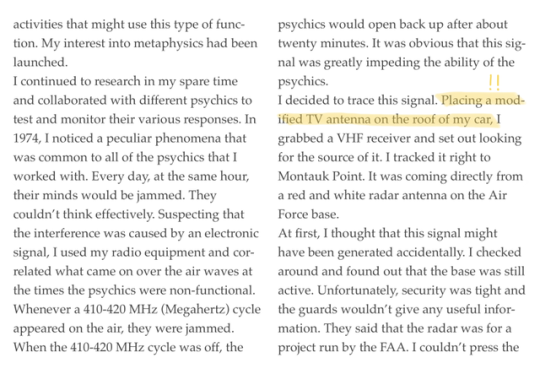
Also, did you catch the whole 'attaching a massive antenna on the hood of my car to pick up a secret signal' thing? That's suspiciously similar to the state of Steve's car! Anyway...
The story of Stranger Things starts chronologically, as does Montauk, with the disappearance of the USS Eldridge and Project Rainbow (named after the bending of the visible light spectrum). Brenner’s father was revealed to have captained the boat in TFS, which disappeared for 12 hours into Dimension X and when it came back, the crew was killed or driven mad (except for Brenner Sr). This inspires Brenner to continue onto the Nevada project, and eventually, Hawkins National Lab’s studies. The USS Eldridge / Philadelphia Project conspiracy from real life went as follows:
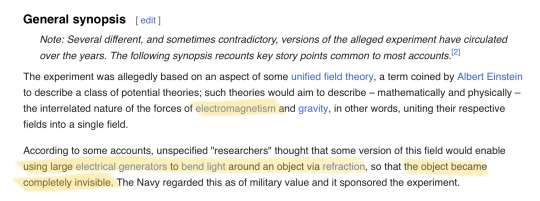
They were studying electromagnetism, specifically the bending of light, to make objects invisible. This was only the first step in the experiments. Once Henry got involved and came back from his trip to Dimension X with powers, Brenner must have realized he could potentially use human subjects to manipulate electromagnetic fields themselves. Human subjects didn’t require machinery or set up and could bend space-time wherever they pleased, as long as they were able to learn the ability.
The more conspiratiorial side of Theoretical Physics proposes using circulating light beams to warp time-space, creating a wormhole in which one can literally walk through time. This is pop-science, likely not true but interesting for fiction purposes. This method of time travel being used is heavily implied due to the fact that the USS Eldridge was already able to disappear into another dimension by the bending of light.

This is how it worked in the Montauk Project book (absolutely ridiculous how much they took from this honestly):

My guess is that in the Stranger Things universe, they have not yet managed to time travel, only to create portals into this alien Dimension X. Previously, said portals were only made twice by highly advanced technological equipment. El demonstrated that she was able to open a portal all by herself - another step to achieving time travel with singular human subjects. Season five is when we will see the beginning of the time travel plot line, though it like in Montauk is likely already in a loop.
That’s where we get the name for the Rainbow Room, named after this Project Rainbow. The rainbow represents the full spectrum of visible light, and the goals of the project to bend said light into portals and eventually time travel wormholes.
Implications?:
-Well, first of all it seems very obvious by this point that we are going for a time travel plot line, and this is how it will be achieved.
-Will is heavily connected to light in general, the sun, and of course… the rainbow. He is also implied be the one involved in the time travel plot line. This will be very relevant going forward and deserves it’s own post. Potential funniness of defeating Vecna with the power of the rainbow afoot.
-Coma patients are known to have odd, barely detectable brain waves. The kids will be able to communicate with Max in her coma using the electromagnetic spectrum somehow, probably through the radio waves.
-On the farthest end of the spectrum, we have ionizing gamma ray radiation, which is known to cause cancer in humans. Expect Hopper’s daughter Sara to connect to this plot line (and perhaps Sam Owens’ dead son). There is a whole theory on this site already called radiationgate. I have not managed to look into it yet but I think they are probably onto something there. The original al pitch mentions the UD leakage into the real world causing cancer as well.
#stranger things#dr brenner#will byers#max mayfield#byler#<- fuck it intended audience#el hopper#st theory#electromagnetismgate#:)#tagging them for the exposure cause idk who is going to see this#time travel
345 notes
·
View notes
Text
Our Roman Space Telescope’s Dish is Complete!
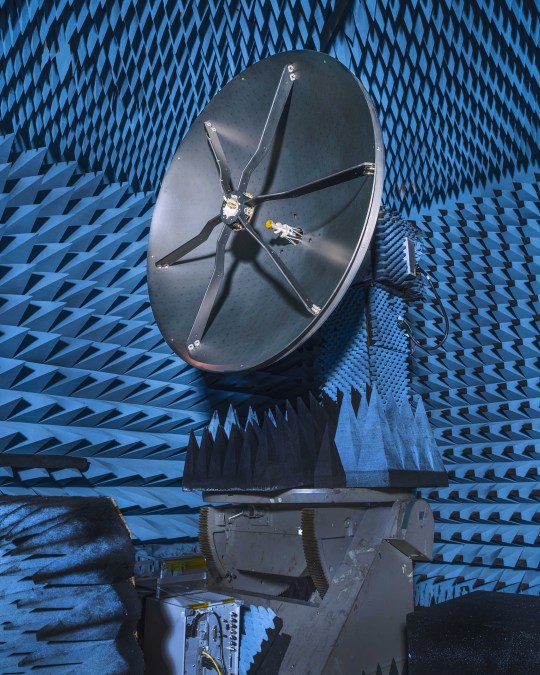
NASA engineers recently completed tests of the high-gain antenna for our Nancy Grace Roman Space Telescope. This observatory has some truly stellar plans once it launches by May 2027. Roman will help unravel the secrets of dark energy and dark matter – two invisible components that helped shape our universe and may determine its ultimate fate. The mission will also search for and image planets outside our solar system and explore all kinds of other cosmic topics.
However, it wouldn’t be able to send any of the data it will gather back to Earth without its antenna. Pictured above in a test chamber, this dish will provide the primary communication link between the Roman spacecraft and the ground. It will downlink the highest data volume of any NASA astrophysics mission so far.
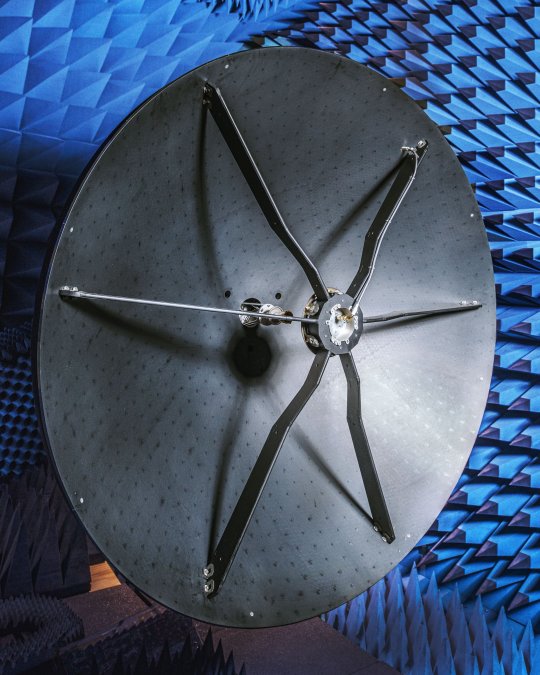
The antenna reflector is made of a carbon composite material that weighs very little but will still withstand wide temperature fluctuations. It’s very hot and cold in space – Roman will experience a temperature range of minus 26 to 284 degrees Fahrenheit (minus 32 to 140 degrees Celsius)!
The dish spans 5.6 feet (1.7 meters) in diameter, standing about as tall as a refrigerator, yet only weighs 24 pounds (10.9 kilograms) – about as much as a dachshund. Its large size will help Roman send radio signals across a million miles of intervening space to Earth.
At one frequency, the dual-band antenna will receive commands and send back information about the spacecraft’s health and location. It will use another frequency to transmit a flood of data at up to 500 megabits per second to ground stations on Earth. The dish is designed to point extremely accurately at Earth, all while both Earth and the spacecraft are moving through space.

Engineers tested the antenna to make sure it will withstand the spacecraft’s launch and operate as expected in the extreme environment of space. The team also measured the antenna’s performance in a radio-frequency anechoic test chamber. Every surface in the test chamber is covered in pyramidal foam pieces that minimize interfering reflections during testing. Next, the team will attach the antenna to the articulating boom assembly, and then electrically integrate it with Roman’s Radio Frequency Communications System.
Learn more about the exciting science this mission will investigate on Twitter and Facebook.
Make sure to follow us on Tumblr for your regular dose of space!
#NASA#astronomy#telescope#Roman Space Telescope#engineering#space hardware#dark energy#dark matter#space#technology#tech
2K notes
·
View notes
Text

GSM 15dBi Yagi Antenna with RG58 Cable (L-10CM) + N (F) St. Connector
ETEILY Manufactures Yagi Antennas with good performance that comes handy, suitably working in all environment conditions.Our directional antennas are both suited for domestic as well as commercial applications.
Robust Mechanical design
High Gain
Good Signal Reception
Better Signal to Noise ratio
#Yagi–Uda antenna#Yagi antenna#Yagi beam antenna#rf antenna#RF Antennas#RF Antenna at Best Price in India#RF antenna system#radio frequency antenna#Best RF Solution Provider#RF Antenna Suppliers#Manufacturer of RF Antenna#rf antenna manufacturers in india#RF Antenna Manufacturer#RF Antenna Exporters#RF Antenna Latest Price#Wireless HF Antenna#RF Antenna Companies in India#Wholesaler of RF Antenna#RF Antenna Amplifier#RF Antenna Module#2.45 GHz Antenna Module#High Performance RF#Antennas for LoRa and Sigfox#Omni-directional SMD antennas#3.3GHz RF Antennas#RF & Microwave Antenna Manufacturers#Antenna manufacturers in Canada#RF Antenna manufacturers & suppliers - India#RF Antenna made in India#India telecom rf antenna
0 notes
Text
𝟷𝚔 || 𝐀𝐍𝐎𝐓𝐇𝐄𝐑 𝐃𝐀𝐘
♡ ︎ꜱᴜᴍᴍᴀʀʏ: Just another normal day with the boys.
♡ ︎ᴡᴀʀɴɪɴɢꜱ: None
♡ ︎ꜱʜɪᴘ: Dead poets society x Reader

You’re late to breakfast again, because, let’s be honest, getting up at the crack of dawn isn’t your idea of fun. Neil is already waiting outside your dorm, practically bouncing on his heels.
"You're going to make us late for chemistry," he says, grinning, but you know he doesn’t care. He’s more excited about rehearsals later.
"Please, it’s just chemistry. What’s the worst that could happen?"
Cue Meeks walking by, fiddling with some kind of strange contraption made of wires and gears. “The worst? You could accidentally discover a chemical that wipes out our entire dorm.”
You blink. “…Is that what you’re working on?”
"He's not wrong," Pitts chimes in, balancing a stack of textbooks. “I’m still not sure what we made in class last week. Meeks said it was a radio, but—”
"It was a radio!" Meeks interrupts, offended. “We just… haven’t found a signal yet.”

Charlie greets you all with a dramatic bow at the dining hall entrance, smirking as always. “Ah, if it isn’t my favorite lady. Come, join me for breakfast. I saved you a seat next to yours truly.”
You roll your eyes but take the seat, because let’s face it—arguing with Charlie Dalton is both pointless and highly amusing.
Todd’s already there, quietly poking at his scrambled eggs like they might come alive and attack him. He looks up, glancing at you, then quickly averts his eyes.
“Good morning, Todd,” you say, leaning a little closer just to see if he’ll blush.
He does. "Uh, g-good morning."
Neil slaps him on the back a little too enthusiastically. “Relax, Todd! She’s not going to bite.”
Charlie, leaning back with an exaggerated sigh, stretches an arm across the back of your chair. “Although, she does seem like the type, doesn’t she? A real heartbreaker.”
Neil elbows him before you can respond. “Careful, Dalton, she might take that as a challenge.”
Across the table, Knox is staring wistfully into space, most likely daydreaming about Chris—again. He hasn't touched his food, too busy scribbling something in his notebook, probably a love letter.
“You’re still writing those?” you ask, raising an eyebrow.
“I think she’ll appreciate the poetry,” Knox says dreamily. “I’ve just got to find the right words. Something that’ll really speak to her soul.”
“Yeah, you and every other lovesick poet in history.” Charlie says, leaning in way too close to you with that smirk. “You know, I could write a love letter… right now… addressed to you.”
“I could throw a book at you right now,” you fire back, raising your diary threateningly. He raises his hands in surrender, but not before tossing in another playful wink.

Todd's buried in a book, his foot tapping nervously under the desk. You nudge him, trying to bring him back to reality. “Relax, Todd, it's just a pop quiz. What’s the worst that could happen?”
Todd looks at you with wide eyes, whispering, “Uh… failing? Public humiliation? Charlie staging a protest because we’re being ‘oppressed by academia’?”
You grin. “I’m surprised Charlie hasn’t done that already.”
Across the room, Pitts and Meeks are still quietly tinkering with the radio, muttering about antenna lengths and frequency adjustments. “Try 89.5,” Pitts suggests.
Meeks sighs. “We’ve tried 89.5 like six times, Pitts.”
Charlie overhears, leaning back in his chair. “Maybe it’s not the signal you’re missing. Maybe the universe just doesn’t want you to hear it.”
You roll your eyes at the dramatics. “Or maybe you two just need to admit your invention is a little cursed.”

Mr. Keating’s class is the highlight, as usual. Today, he’s making everyone stand on their desks to recite poetry.
“Well done!” he says, clapping. “That’s the spirit, seize the day!”
Charlie gets up next and, of course, winks at you mid-recitation. "What is life, if not the pursuit of—”
“Dalton, sit down before you fall,” Keating interrupts, though he’s clearly holding back a smile.
"Today," Keating says with a gleam in his eye, "we’ll be looking at life through a different lens."
Neil nudges you, whispering, "This is gonna be good."
Charlie, lounging in the back, raises his hand. "Mr. Keating, does that lens involve skipping the rest of class for some fresh air?"
Keating grins, not missing a beat. "Now, Nuwanda, where’s the fun in that? We’ve got poetry to read, minds to bend."
Knox is still writing furiously in his notebook, glancing up every so often to see if anyone’s noticed. "Do you think Chris likes daisies? Maybe roses? What if she’s allergic? Should I ask her?"
Neil glances over. "Knox, you haven’t even spoken to her yet."
Todd, beside you, whispers, "Maybe he should just… say hi?"
"You’re all missing the point!" Charlie exclaims, dramatically flinging his arms. "The real romance is right in front of you!" He points to you, leaning in like he’s about to make a grand declaration.
"Charlie, if you flirt with me one more time—"
"You’ll fall in love with me?"
"Absolutely not."

By the time the day winds down, Pitts and Meeks are still muttering over their radio. "Maybe if we try it with a wire hanger," Pitts suggests, looking deeply contemplative. "I swear I heard a sound earlier."
“I think we need to recalibrate the frequency,” Meeks mutters, twisting a knob.
“You’ve been recalibrating the frequency for three days,” you point out, biting into an apple.
“It’s all about persistence,” Pitts says with a determined nod.
“Or delusion,” Charlie adds, stealing your apple out of your hand and taking a huge bite, just to annoy you.

Afternoon rolls around, and you’re barely keeping up in Latin class, but Neil’s right beside you, scribbling notes like a machine. He gives you a reassuring smile, as if to say, You’ll get it. You won’t, but it’s sweet that he believes in you anyway.
After classes, you all meet by the cave for a Dead Poets meeting, the air filled with the smell of damp earth. Charlie’s reciting some scandalous poem he found, Knox is asking for feedback on his latest love letter, and Todd’s nervously glancing at the fire, probably worried it’s going to get out of control. Neil reads Shakespeare with such passion that you’re half convinced he’s going to run off to join a theater company by the end of the week.
By the time the sun sets, you’re all laughing, a little too loud for the quiet woods around you, but who cares? It feels like, for a moment, the whole world belongs to you and this crazy group of boys.
As you head back to the dorms, Charlie walks beside you, a smirk tugging at the corner of his lips. “So… you coming to watch me play tonight? I’m thinking of dedicating my next solo to someone very special.”
You laugh, pushing him away. “Don’t get ahead of yourself, Dalton.”
He leans closer, voice low. “You can deny it all you want, but we both know you’re just here for my charm.”
“You wish,” you say, shaking your head, but smiling anyway.
Todd trails behind, stammering about needing to study for tomorrow's exam, while Neil drags him back to the group, promising they’ll make time for both. Knox, lost in thought about Chris, sighs dreamily. Pitts and Meeks are still discussing their radio, determined that one day, it will pick up a signal.
As everyone heads back to their rooms, Neil gives you a tired smile. "Another day survived."
You laugh. "Barely."
Todd lingers awkwardly, giving you a shy wave before scurrying off, while Charlie blows you a kiss. "Until tomorrow, my muse."

thank you so much for the request @march32nd!!
i loved writing this one 💕
#𝐀𝐍𝐎𝐓𝐇𝐄𝐑 𝐃𝐀𝐘#𝐃𝐄𝐀𝐃 𝐏𝐎𝐄𝐓𝐒 𝐒𝐎𝐂𝐈𝐄𝐓𝐘#𝐂𝐇𝐀𝐑𝐋𝐈𝐄 𝐃𝐀𝐋𝐓𝐎𝐍#𝐓𝐎𝐃𝐃 𝐀𝐍𝐃𝐄𝐑𝐒𝐎𝐍#𝐍𝐄𝐈𝐋 𝐏𝐄𝐑𝐑𝐘#𝐊𝐍𝐎𝐗 𝐎𝐕𝐄𝐑𝐒𝐓𝐑𝐄𝐄𝐓#dps#dead poets society x reader#dead poets society#charlie dalton x reader#charlie dalton#knox overstreet x reader#knox overstreet#todd anderson x reader#todd anderson#neil perry x reader#neil perry#𝐌𝐈𝐍𝐄 <𝟑
60 notes
·
View notes
Text
Ham Radio: A Personal Account
by Kevin Gillette
Amateur radio, or ham radio as it is more commonly known, has been a hobby for millions of people around the world for approximately 100 years, give or take. It exists today for much the same reason it came about in the first place: it is (and was) a way for both amateur and professional engineers, tinkerers, physicists and inventors to interact with one another, comparing notes, ideas and innovations that have played a major role in the expansion of telecommunications up to the present day.
This brief memoir is not a history of the hobby, for I came into it only 50 years ago, in 1974. As a result, I don’t have first-hand knowledge of most of what came before. But I can sketch the essentials for you, and with any luck, I will persuade you to see how this hobby can bring a great deal of joy and satisfaction. At the end of this account I will provide some tangible evidence of my days at the helm of a transmitter/receiver/antenna combination over the course of several decades.
First, some preliminaries:
Ham radio began about 100 years ago. The very first enthusiasts used very primitive equipment for both transmission and reception. The earliest transmitters used a technique called spark gap in which the radio signal arose from a spark generated between two electrodes. The frequency of this transmission was dictated by the physics of the electrodes and the gap between them.
For frequency, think of your standard AM and FM broadcast bands, or local television. Radio emission occurs when an electrical field rapidly reverses direction – that is, electrons flow back and forth through a wire or some other device capable of supporting an electromagnetic field. The speed with which this flow of electrons reverses course determines the frequency; the faster the course reversal, the higher the frequency. A single round trip of the electrons is usually referred to as a cycle. Thus, frequency is expressed in cycles per second, or in an equivalent unit, Hertz (one Hertz = one cycle per second). All electromagnetic radiation can be expressed this way. Radiation typically occurs when the flow of electrons alternates direction - electron flow goes by the term current, and so radiation happens with alternating current, or AC. In many (though not all) countries, the electricity that comes out of a wall plug is AC. The opposite of AC is DC - direct current - and this is the case when the electrons always flow the same direction. In essence, DC is zero Hertz AC.
The range of hearing of most humans is between about 60 Hertz (Hz) and roughly 10,000 Hz (this is also indicated as 10 kiloHertz, or 10 KHz). In the United States, the AM broadcast band is from 540 KHz to 1600 KHz (this latter measurement is also expressed as 1.6 megaHertz, or 1.6 MHz). Standard television signals have traditionally begun at 54 MHz, which each television channel occupying a total of 6 MHz. So this means that Channel 2 (for obscure reasons, there is no Channel 1) is from 54 – 60 MHz, channel 3 from 60 – 66 MHz, and so on. There is a break in this pattern for the U.S. FM broadcast band, which lives from 88.0 – 108.0 MHz; the TV channels then continue up to channel 13. The channels 2 through 13 are called the VHF - Very High Frequency - channels. After channel 13 there is another significant frequency gap, after which the UHF, or Ultra High Frequency channels begin, with channel 14.
I’ve mentioned a couple of undefined terms: AM and FM. AM stands for Amplitude Modulation. This was the earliest method used for transmitting sound signals (voice, music, etc). It works by using a central frequency known as the carrier and superimposing an audio frequency on it, resulting in the actual size of the emission varying (at the carrier frequency) according to the audio frequency. This methodology gives rise to what are called sidebands, which cover the frequencies between the carrier frequency plus and minus the audio frequency. This is still used today on the AM broadcast bands in most countries. It is rather wasteful in terms of power, since a lot of the transmitted signal power is in the carrier itself rather than the sidebands where all the good stuff is. For this reason, ham radio operators who do voice transmissions have, since about the 1940s or so, used something called SSB, or single sideband transmission. In this mode, one chooses one of the two sidebands (lower or upper) and suppresses the other one as well as the carrier, meaning that most of the transmitted power goes into the information in the signal rather than being wasted. A more recent form of transmission is FM - Frequency Modulation. In FM transmission, instead of varying the amplitude of the carrier wave as a function of the audio content, the frequency wiggles according to the superimposed audio content. In AM transmission, static and other interference phenomena tend to occur at the peaks of the modulation waveform (see the figure below); with FM, the peaks of the waveform don’t contain information so they can be filtered out, and this gives rise to the notion - largely true - that FM is static-free. Here is an example AM waveform as seen on an oscilloscope:

For comparison, here is an example of an FM waveform as seen on an oscilloscope:

In this latter picture, notice how the amplitude of the waveform doesn’t change, but the spacing between the cycles does – this is the wiggle in the frequency I referred to earlier.
I mentioned voice operations in ham radio using a technique called SSB. There are other techniques, especially at the higher frequencies, but I’m not going into those here. I admit that I am something of a purist; I have always preferred to use Morse Code in my ham radio exploits. This is known as CW - Continuous Wave - in the ham radio community. The idea is that to transmit Morse Code, one merely turns a carrier – a continuous wave – on and off with a Morse Code key or something equivalent to it. Speed of transmission is usually expressed in words per minute - wpm. Although the requirement is gone today, in the past, obtaining a ham radio license required the operator to demonstrate at least a basic proficiency in Morse Code, usually somewhere between 5 and 20 wpm. A word in this context is a group of 5 characters and the space after them. I’m proud to say that at my peak, I could listen to – “copy” – transmissions running at about 45 wpm. The world record in those days was somewhere in the neighborhood of 75 wpm, and high-speed code operators in the US Navy and elsewhere typically operated at around 50 wpm, so I was competitive in the CW community as far as speed.
I’ve talked a lot about transmission, but of course it’s all for naught if there’s no way to hear the signal. To do this, one needs a receiver. Receivers are generally much more complicated devices than transmitters – even a modern transmitter can often be constructed with perhaps a dozen discrete parts, including the power supply (or batteries), whereas modern receivers typically need about 10 times that amount in order to be effective and reliable. This is because transmitting is essentially an increasing entropy operation from a thermodynamic perspective, whereas receiving is a decreasing entropy operation, which fights against the tendency toward greater entropy according to the 3rd Law of Thermodynamics. This is much the same as it being a lot easier to generate heat than to remove it from an environment. Receivers are far too complicated to get into here, but I will note that for the kind of work I did – CW and Morse Code – the way the signal could be heard was to tune the receiver to a frequency just slightly to one side of the transmitting carrier frequency and use what’s called a BFO - Beat Frequency Oscillator - to provide a sidetone that represents the difference between the BFO frequency and the carrier frequency. This will be important a bit later, so remember that term.
And of course the ensemble isn’t complete without some kind of antenna. Like both transmitters and receivers, antennas can be everything from a simple piece of wire to a very elaborate contraption that covers a lot of real estate. The rule of thumb is that the higher the frequency, the smaller the antenna needs to be. A very common kind of antenna used on the lower ham radio bands is a vertical antenna, which as the name implies, is a piece of metal (usually aluminum) that is vertically installed. The cable that connects the antenna to the transmitter and receiver is usually attached at the bottom of such an antenna – a picture of such an arrangement appears below:

In this photograph, the antenna has some extra horizontal spokes coming off of it at various points – these are used to suppress capacitance effects of the central pole (the fact that it’s a hollow tube and not an infinitely thin wire causes some of these issues to arise) and to otherwise improve the performance of the antenna.
I haven’t said much about power, so I’ll do so now. Where commercial broadcast stations can transmit at quite high power – varying from 1000 watts to upwards of 100,000 watts – ham radio is restricted to a maximum of 1000 watts for CW and 2000 watts for SSB. I was typically a low-power operator, seldom going above 50 watts and often no more than 10 watts. And yet I was able to make contact with people all over the world on such modest power, so it doesn’t take a lot. An effective antenna system and favorable geography are the primary arbiters of how well one can communicate over long distances.
Something else I mentioned but haven’t yet elaborated on is the licensing process. In the United States, there used to be the following levels of licensing, from the most basic to the most advanced: Novice, Technician, General, Advanced, Extra. I began my ham radio career as a Novice, as everyone did in those days. My radio call sign was WN6FEB (see photo below). To obtain a Novice license, one had to know some basic electronic and radio theory, some basic regulatory stuff (power, bands, on-air protocols, etc) and have mastered Morse Code at 5 wpm. I obtained this license when I was 13 years old. A short time later I upgraded to a General class license and a slightly new call sign, WA6FEB, which extended the radio frequency bands I was permitted to operate on and also extended my maximum output power (as a Novice I was restricted to 100 watts, I think). The General class license required knowledge of more advanced electronics and radio physics, a bit more regulations and Morse Code proficiency of 13 wpm. A few years later I took the plunge and got my Extra class license, which expanded the knowledge base from the previous two licenses and required Morse speed of 20 wpm. As an Extra class ham, I had unlimited access to all internationally agreed-upon ham frequency bands and full power rating. My main motivation in getting the Extra class license was the radio bands – I was never a high-power operator.
My Novice license QSL card (more on this in a moment):
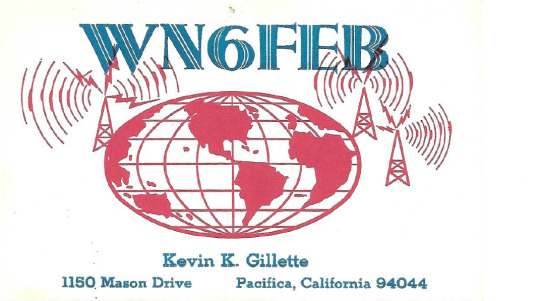
My Extra class license QSL card:
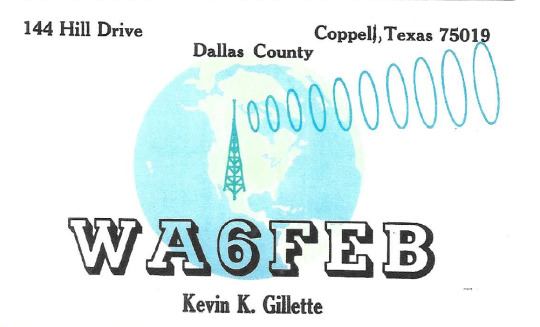
QSL cards are like postcards for hams – we often exchange them to acknowledge that we’ve made contact. They’re often attractive and make great wallpaper or collectibles. I’ve amassed quite a few over the years – there are examples of QSL cards received from around the world at the bottom of this article.
Dovetailing with a previous paragraph, a few words about ham radio frequency bands. Per international agreement, ham radio operators have a large number of radio spectrum segments allocated for their use. It should be noted that in many cases, these allocations are not exclusively for ham radio. One example is the 40-meter band, which covers 7.0 – 7.3 MHz. At least in the 1970s and 1980s, this band featured a lot of non-ham activity, including over-the-horizon radar from the USSR and Voice of America broadcasts from various parts of the world. What made this especially annoying is that the 40-meter band was almost universally open, meaning that effective communication could happen on that band at any time of the day or night, year-round. The Soviet radar sounded like a very loud metronome, and Voice of America was an AM transmission in a segment of the radio spectrum where people didn’t normally use AM, meaning that receivers tuned to this part of the spectrum ended up hearing the carrier as well as the audio signal (which made the audio portion hard to understand). Still, for a young ham radio aficionado hunting for exotic call signs in the ether, it was a lot of fun to wade among the incoherent mass of radio transmissions.
The bands are usually referred to by their approximate wavelength. Recalling that light travels at approximately 300,000,00 meters/second, here is a sample of some of the bands that were popular when I first started back in 1974 (there have been additional bands added to the spectrum since that time; I have no experience on those bands):
HF:
160 meters – 1.8 – 2.0 MHz (I didn’t have any contacts on this band, but my older receiver permitted me to listen in. The antenna requirements for this band are too large for the real estate I had.)
80 meters – 3.5 – 4.0 MHz
40 meters – 7.0 – 7.3 MHz
20 meters – 14.0 – 14.35 MHz
15 meters – 21.0 – 21.45 MHz
10 meters – 28.0 – 29.7 MHz
VHF:
6 meters – 50.0 – 54.0 MHz (note that this is just below the start of the standard television broadcast segment, Channel 2, as noted earlier)
2 meters – 144.0 – 148.0 MHz
I also mentioned the idea of a band being open. On the HF (High Frequency) bands, the propagation of a signal often proceeds in two ways: ground wave and sky wave. Ground wave is exactly as the name implies; the radio signal follows the ground. This signal is of comparatively short distance, perhaps 100 miles or thereabouts. Sky wave is quite a different phenomenon and involves the signal bouncing off of the ionosphere, a layer of our atmosphere that lives between 50 and 600 miles above the Earth’s surface. As the name suggests, this layer contains a lot of ionized particles - mostly from the Sun’s interaction - and it is this layer of ions that forms a sort of reflecting barrier for radio waves below a certain frequency. The highest frequency for which the ionosphere is a reflecting barrier is referred to as the MUF - Maximum Usable Frequency. Above this frequency, radio transmissions pass through the ionosphere and out into space. When a band is open, that means that the MUF is greater than the band’s frequency, at least as an approximation. The 40-meter band is virtually always below the MUF, meaning that it’s open all of the time. This is what makes it so popular. The 20-meter band is often (though not always) open, which is what makes it a premium band for long distance communications, referred to in ham radio parlance as DX (which stands for distance). The 20-meter band has the advantage that it is strictly for ham radio – no competing services cause interference and noise. When an HF band is open, the sky wave mode of signal propagation is also referred to as skip, meaning that the signal will skip off of the ionosphere, sometimes multiple times – this makes for worldwide transmission and reception.
You may be asking yourself what was in it for me, that I would have such fervor for a hobby that is admittedly declining in popularity (with the advent of email and the Internet). I think a simple anecdote will make it clear:
When I was about 15 years old, early in my ham radio career, I lived in a small town near San Francisco and also near Stanford University. I had an on-air friend named David Gray, WB6ZMJ, who was a graduate student in geophysics at Stanford. David was a member of the Stanford Amateur Radio Club (SARC):
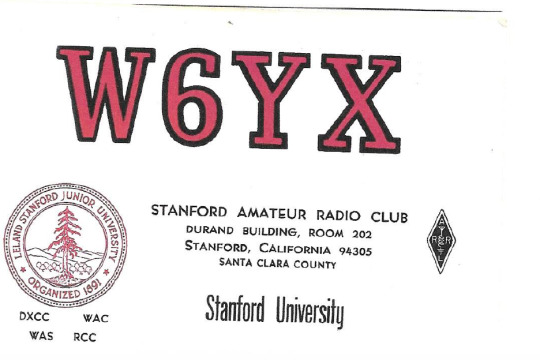
One weekend he invited me down to Stanford to participate in what is known as moonbounce. In moonbounce, hams from across the globe will transmit on the VHF frequencies directly up to the Moon, bouncing their signal off the Moon to be received somewhere else on the planet. Recall what I mentioned above about the MUF; the VHF frequencies are all well above the MUF, so VHF signals cannot participate in the skip mode of propagation (except under some very unusual circumstances). Stanford University has an enormous radio telescope, affectionately referred to as The Dish, that sits on a small hill on the SW side of campus. A picture of it appears below. The Dish is about 150 feet across and was built in 1961. It remains in use to this day. The SARC used The Dish as their antenna for moonbounce activity.
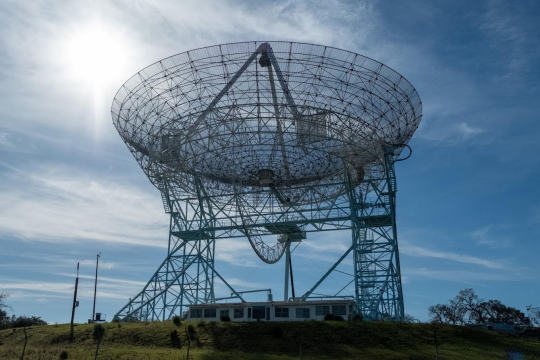
Here's the rub: The path length from Earth – Moon – Earth (EME) is about 500,000 miles. The loss in signal strength approaches 250 dB, which equates to dropping from a Formula 1 roar down to the tiniest of whispers. In fact, the signal strength is so low that even when using CW, the signal isn’t strong enough to trigger a BFO for a sidetone in order to read the signal. The only way to hear the signal is to listen for quiet spots in the background noise! That’s where I came in on this particular occasion. I have (and have always had) exceptionally acute high-frequency hearing, and so what sounded like white noise to the grad students in the SARC was an intelligible signal to me. So, in the middle of the night, there I was, in the metal housing seen at the base of The Dish, listening to a mysterious CW signal from a ham in Sweden coming by way of deep space, and writing down what I heard. For a lonely, nerdy kid, this was the height of affirmation – it was OK to be nerdy and science-oriented when you got to play with such exotic toys! Indeed, not only did this experience cement my desire to pursue ham radio; it also confirmed that Stanford was the place I wanted to pursue my university studies (as indeed I did, graduating with a Bachelor’s degree in applied mathematics and a Master’s degree in operations research, all before my 21st birthday).
In the years following graduation from Stanford, I got married and moved to Dallas, Texas, where once we purchased our first home, I immediately set up a nice ham shack in the laundry room. I made tons of great contacts all over the world with the most modest of equipment (alas, I don’t have any photos of my gear from those days). When we started our family, the hobby had to take a back seat, and eventually I let my license lapse. But now that I am approaching retirement age, I long once more to get back on the air and hunt for those mysterious signals beaming in from everywhere.
Kevin Gillette, 26 January 2024
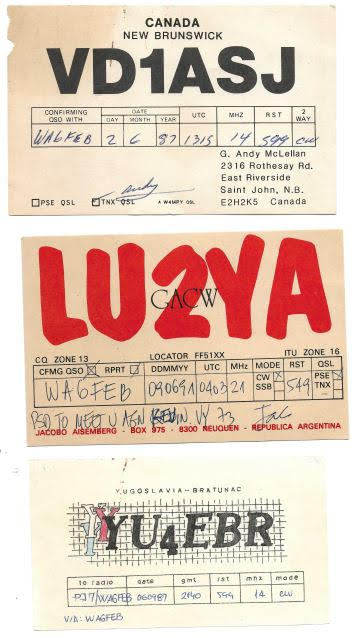
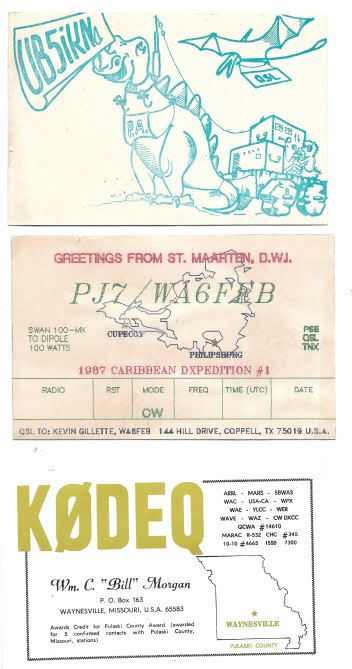



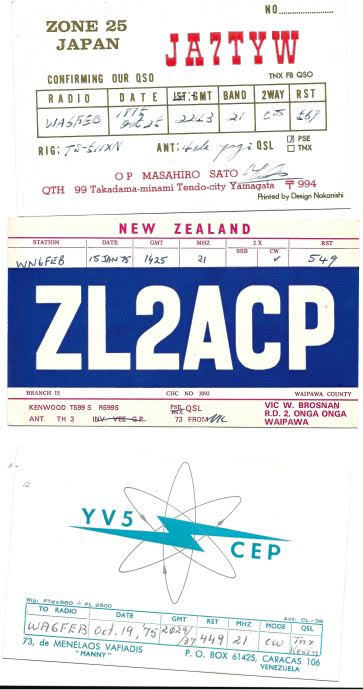

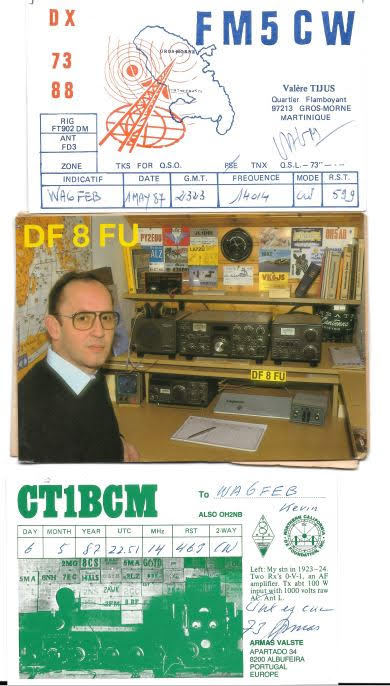

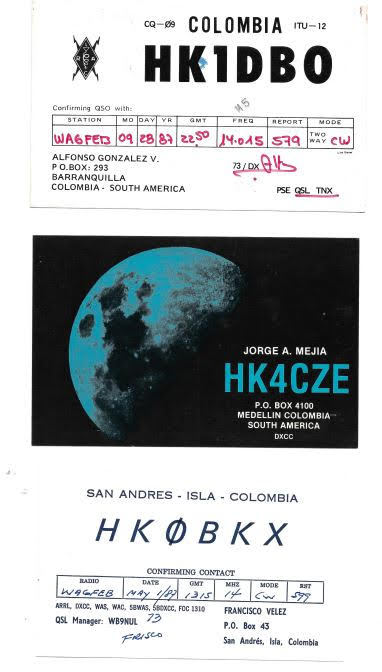
Image credits : Images in the text with thanks to © respective creators and publishers. QSL Cards at end of article above received by author, with thanks to © respective creators
Kevin Gillette
Words Across Time
26 January 2024
wordsacrosstime
#Words Across Time#Kevin Gillette#wordsacrosstime#January 2024#Amateur Radio#Ham Radio#Broadcast Bands#Electromagnetic Field#Stanford Amateur Radio Club#Beat Frequency Oscillator#US Navy#Morse Code#SSB#AM#FM#Maximum Usable Frequency#Sidetone#Sidebands#Continuous Wave#Antenna#Spark Gap#Hobby#Tinkerers#Inventors#Telecommunications#VHF#Frequency Modulation#Amplitude Modulation#Alternating Current#Direct Current
1 note
·
View note
Text

"The way into our own DNA is via tapping into the Key of Phi,
permitting entry into the towering dodecahedral wratcheting spiral staircase that we call DNA,
a waveguide or antenna allowing us how to turn ourselves inside out,
via obeying the strict twisting rules of the Powers of Phi
which is the evolution of the 1-dim Fibonacci Sequence to a 2-dim nautilus shell spiral to a 3-dim rams horn to a 4-dim torus.
The future in medicine is following this vibrational 5-dim path,
this DNA radio that can talk-transmit to you, open its door-window to you,
so that you can merely replace the dysfunctional or old school codes with the new templates of Love Geometry.
The Phi Harmonics are a natural part of our evolving Field, of Consciousness.
This topic, tuning into the Living Curvation of Nature,
thus keeps us connected and awakened with the micro
Golden Curves of the atom and the macro galaxies."
--Jain 108
DNA And Spiritual Awakening
Light is a vibrational frequency that carries the codes of creation.
DNA is activated via spiritual awakening to create the Light Body.
Light codes for twin flames: 11:11, 222, 333, 444, 555, 144, 1141, 1144, 1212, 1010, 313, 711, 717, 414, 515, 818
Light Codes: What Is Light Code Activation?
55 notes
·
View notes
Text
The Rise of E-Passports: Enhancing Security and Convenience in Travel

The Global E-Passport Market report provides insight into global economies as well as business perspectives on macroeconomic factors affecting the market. A detailed breakdown of the market structure, as well as significant business trends and challenges, is included in the report. This research report also analyzes historical data and future business opportunities in the global e-passport market.
Business cycles, demographics, and microeconomic requirements have been evaluated in this report to comprehensively understand the global e-passport market. Furthermore, the global e-passport market study specifies an in-depth analysis of the current business circumstances. This study report also evaluates a variety of financial factors like production value, growth rate, and key regions in order to identify ways to increase the company's revenue.
The following key players dominate the e-passport market:
ASSA ABLOY AB
Thales Group
De La Rue Plc
Giesecke & Devrient GmbH
IDEMIA France SAS
Entrust Datacard Corporation
HID Global Corporation
Infineon Technologies AG
Muhlbauer Group
Thales Group
Request for Sample PDF: https://www.nextmsc.com/e-passport-market/request-sample
A list of the largest players in the global e-passport market is provided in this report, allowing you to gain a deeper understanding of those companies. In order to educate businesses about growing their business, this data will be of benefit to both existing and emerging companies.
Throughout the world, production facilities have struggled due to strict lockdowns imposed by the COVID-19 pandemic.
Furthermore, certain prominent players experienced a drop in demand for their products as a result of changes in consumer behavior toward their spending patterns. As the industry recovers from the pandemic, the global e-passport market is expected to grow significantly in revenue by the year 2030.
There have been various research methodologies used for the global analysis of the e-passport market, including primary and secondary research, PESTEL and SWOT analyses, and Porter's five forces model, among others. It has been the objective of this study to provide a better understanding of prices, costs, revenues, and numbers using statistics and figures, and tables.
Sales, demand, product advancements, and production capacity are covered in this report, as well as a comprehensive overview of the e-passport market. Additionally, the report analyzes various segments of the global e-passport market, as well as supply chains, distribution chains, and company execution across regional markets. This report will help prominent as well as new entrants in this industry to assess their production, marketing, and sales approaches.
By type, the e-passport market can be categorized into:
Ordinary E-passport
Service
Diplomatic E-Passport
In terms of applications, the market for e-passport is further divided into:
Leisure Travel
Business Travel
Several aspects of this industry are included in the global e-passport market research report, including future growth prospects, business plans, and sales figures. The focus of this report is on forecasted market sizes as well as market shares of companies in the e-passport market. As a result, several economic and social factors have a greater impact on the business than they have ever been. In this study report, critical information is provided to assist businesses in developing effective strategies for promoting their products and services.
Using the information in this report, companies can formulate business plans and strategies based on the changing market trends by analyzing market dynamics and perspectives. By understanding the market trends and dynamics, companies will be able to grow and stay competitive. To ensure the validity of the data quoted in this report, scientific papers and other credible sources were reviewed.
Furthermore, the report includes forecasts about growing companies in the industry based on their segmentation by region. According to the geographical regions, this research examines the global markets in North America, Europe, Asia-Pacific, Latin America, Africa, and the Middle East. Essentially, it examines future revenue potentials and trends in business and how businesses can benefit from technology advancements.
About Us
Next Move Strategy Consulting is a premier market research and management consulting firm. We are committed to providing strategically-analyzed and well-documented research reports to our customers. What makes us different from the rest is our top-quality research and the obsession with turning data into knowledge by analyzing it thoroughly and providing fact-based research recommendations. We collect information from over 500 million websites, paid databases, industry journals, and one-on-one consultations with industry experts across various sectors. The high-quality customized research reports with actionable insights and excellent end-to-end customer service also help our customers make critical business decisions and gain a competitive edge in the industry.
We have serviced over 1,000 customers globally, including 90% of the Fortune 500 companies over a decade. Our analysts constantly track various high-growth markets and identify hidden opportunities in each sector or industry. We provide one of the best syndicated and custom research reports across 10 different industry verticals. Our industry-standard delivery solutions range from pre-consultation to after-sales services. We offer an excellent customer experience and help our customers make strategic business decisions.
#E-Passport Market#Radio Frequency Identification#Biometrics#Facial Recognition#Fingerprint Recognition#Iris Recognition#Hardware#Antenna#Processor/Chip#Software#Services#Leisure Travel#Business Travel#Basic Access Control (BAC)#Password Authenticated Connection Establishment (PACE)#Supplemental Access Control (SAC)#Extended Access Control (EAC)#Ordinary E-passport#Service#Diplomatic E-Passport
0 notes